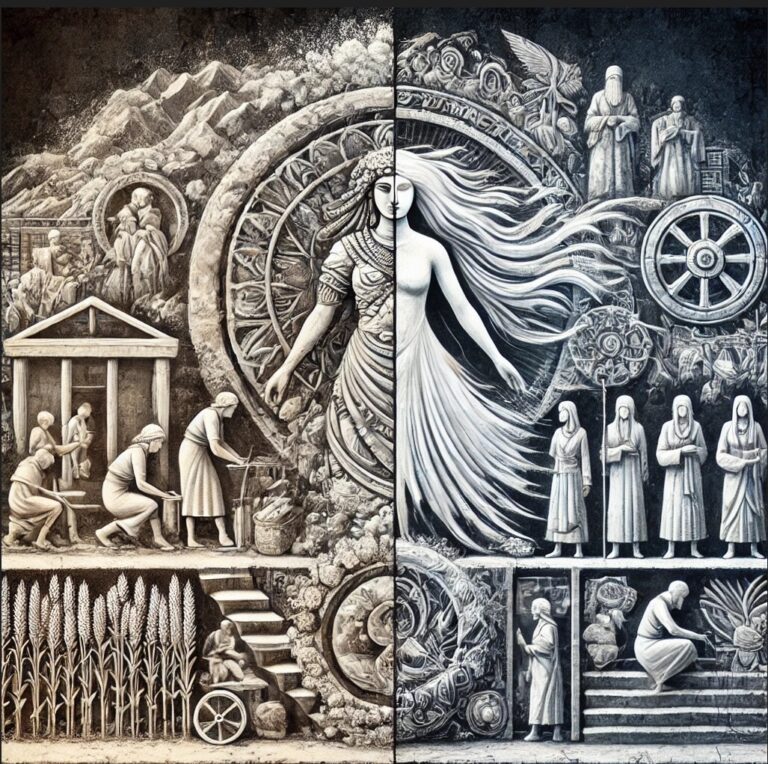Part 3: Matriarchal Societies and Their Characteristics

Matriarchy to Patriarchy: The Gendered Roots of Power & Poverty
Part 3: Matriarchal Societies and Their Characteristics
Introduction
As we continue our exploration of gendered power structures, this third part of our series delves into the characteristics of matriarchal societies, their historical significance and the theories surrounding their evolution. From early kinship structures to the gradual transition into patriarchal systems, we examine how gender roles and leadership evolved over time.
Matriarchal societies, often misunderstood and debated, were not merely the inverse of patriarchy. Instead, they functioned based on kinship, communal cooperation and economic contributions rather than hierarchical dominance. These societies laid the foundation for early civilisations and governance structures, which later transformed as power dynamics shifted.
Early Matriarchy
Matriarchy refers to a social system in which kinship, inheritance and governance are predominantly traced through the maternal line. While no known civilisation functioned as a complete matriarchy (where women ruled over men), historical evidence suggests that early human communities prioritised gender balance and often followed matrilineal structures.
In early human settlements (7000–3500 BCE), kinship was determined by maternal descent, as the paternal lineage was not always identifiable. Dual exogamy, a system where marriages occurred between members of different kinship groups, was a common practice to strengthen alliances and expand communities.
Early matriarchy was characterised by activities such as hunting, gathering and primitive fishing, which were essential for survival and contributed to the communal economy. Another defining feature of early matriarchy was its dispersed settlement structure, where people lived across multiple dwellings, as well as matrilocal residence, in which families lived in a single shared household led by the maternal lineage. These practices reinforced communal bonds and ensured the collective well-being of extended family groups.
Women played a significant role in the development of agriculture, food storage and animal domestication, which gave them economic and social influence. The nurturing and protective role of women, combined with their contributions to food production, elevated their status within early societies and established them as key decision-makers in communal life.
Developed Matriarchy
During the Neolithic period, matriarchal elements became more structured. Women not only managed households but also played leadership roles in trade, spiritual practices and communal decision-making. Archaeological evidence suggests that these societies were largely egalitarian, prioritising harmony over rigid hierarchy.
Developed matriarchy was distinguished by the practice of agriculture using primitive tools, such as the hoe, the expansion of matriarchal kinship groups, and the consolidation of tribal structures and pair-based families. Matrilocal residence—where the husband moved to live with the wife’s family—became the predominant norm, reinforcing the central role of women in family structure and inheritance.
However, by the end of the Neolithic era, elements signalling the decline of matriarchy began to emerge. This process culminated in the Bronze Age, when matriarchal structures were fully replaced by patriarchy. Several factors contributed to this shift, including:
- The increasing importance of warfare and territorial defence, which favoured male-dominated leadership.
- The shift from subsistence farming to large-scale agriculture, which required heavier labour, often assigned to men.
- The concentration of economic and political power in fewer hands, reducing the collective decision-making structure that had previously existed.
These developments gradually eroded matriarchal traditions, ultimately leading to the dominance of male-led governance and social hierarchies.
Theories on Matriarchy
The idea of matriarchy has been widely debated among scholars. Below are two of the most influential theories:
Johann Jakob Bachofen’s Four Phases of Societal Evolution
The Swiss anthropologist and sociologist Johann Jakob Bachofen (1815–1887) was the first to introduce the concept of matriarchy, although he did not use this specific term. His groundbreaking work, Das Mutterrecht (Mother Right: An Investigation into the Religious and Juridical Character of Matriarchy in the Ancient World), published in 1861, explored the social and legal significance of matriarchal systems in prehistoric societies.
Bachofen argued that early societies were dominated by women, asserting that the archaic legal system of maternal descent had a direct correlation with the Christian veneration of the Virgin Mary.
Bachofen’s Key Arguments
- At the dawn of civilization, humans lived in a state of sexual promiscuity, a condition Bachofen termed hetairism.
- Due to this lack of monogamy, paternity could not be determined with certainty, and thus, descent was traced exclusively through the maternal line.
- As a result, women held considerable influence and social power, leading to a system of governance known as gynaecocracy (women’s rule).
- The transition to monogamy, where a woman was restricted to one man, marked the end of female leadership and the rise of male dominance.
Bachofen’s Four Phases of Societal Evolution
Bachofen theorized that societies evolved through four distinct stages, transitioning from matriarchy to patriarchy:
- Hetairism – Early societies were polygamous, with a dominant goddess figure resembling a proto-Aphrodite (Venus in Roman mythology, the goddess of beauty and love).
- Matriarchy – Agriculture became the primary activity, and the dominant deity was a proto-Demeter (the Greek goddess of agriculture).
- Dionysian – A transitional phase where men began asserting their dominance. The central deity was a precursor to Dionysus (Bacchus in Roman mythology, the god of vegetation, wine and fertility).
- Apollonian – Male dominance became fully established, with Apollo as the principal deity (the Greek and Roman god of light, prophecy and the arts).
Bachofen maintained that agriculture first developed within matriarchal societies, where harmonious relationships and maternal love formed the foundation of social structures. He argued that this pattern applied universally, from Spain to India, from Scythia to Africa, and from Greece to Egypt.
According to Bachofen, the shift from hetairism to monogamy and from matriarchy to patriarchy occurred most notably in Greek civilization, driven by evolving religious beliefs rather than material conditions. He posited those new deities and ideological systems gradually overshadowed older ones, leading to a restructuring of gender roles.
Friedrich Engels’ Critique of Bachofen
In the preface to the first edition (1884) of The Origin of the Family, Private Property and the State, Friedrich Engels acknowledged Bachofen’s contributions, stating:
“Bachofen was the first to challenge the notion of an unknown, primitive state of unregulated sexual relations. He demonstrated that classical literature contains numerous references to a time when, before monogamy, Greek and Asiatic societies practiced a form of promiscuity in which both men and women engaged in multiple relationships without violating any social norms. This tradition did not disappear without leaving traces. Evidence of it can be found in the requirement that women offer themselves to other men for a certain period before being permitted to enter monogamous unions. Consequently, early descent could only be traced through the maternal line, from mother to mother. This system persisted long into the era of monogamy, even when paternity was recognized, ensuring that mothers held the primary legal and social position. As a result, women in these societies enjoyed a higher status than they have ever had since.”
Engels challenged the notion of a structured matriarchy. He argued that early societies followed maternal lineage not because of female dominance, but due to the absence of monogamy, making paternity difficult to determine.
Engels viewed the transition to patriarchy as a result of economic shifts, particularly the accumulation of private property. He contended that as wealth became more concentrated, men sought to ensure their inheritance passed through their own lineage, leading to the subjugation of women and the rise of patriarchal norms.
His argument remains relevant today, as many gender inequalities can still be traced back to economic power imbalances.
Bachofen’s Legacy
Johann Jakob Bachofen (1815–1887) was a Swiss historian of law, jurist and anthropologist, best known for his research on primitive family structures and matriarchy. His seminal work, Das Mutterrecht (1861), profoundly influenced later scholars, including Friedrich Engels, whose The Origin of the Family, Private Property and the State critically engaged with Bachofen’s theories.
Engels challenged Bachofen’s idealistic approach, arguing that family and legal history were shaped by material conditions rather than religious concepts. Despite this critique, Bachofen’s work remains foundational in the study of gender roles, social evolution, and early kinship systems.
Religious and Cultural Legacy of Matriarchy
In early matriarchal traditions, women were often associated with fertility, nature and spirituality. Many ancient societies worshipped female deities, including:
- Isis (Egyptian) – The goddess of motherhood and magic.
- Demeter (Greek) – The goddess of agriculture and fertility.
- Inanna (Mesopotamian) – A goddess linked to love, war and power.
Archaeological discoveries, such as clay figurines of pregnant women, indicate that fertility and creation were central to religious practices. These figures are believed to represent the Great Mother Goddess, symbolising abundance and protection.
However, with the rise of patriarchal societies, these deities were often replaced or reinterpreted into male-dominated religious structures. The introduction of warrior gods (such as Ares, Mars, and Yahweh) signalled a shift towards power-driven theological systems, reinforcing male authority.
Conclusion & Looking Forward
The study of matriarchal societies challenges the assumption that patriarchy has always been the dominant structure. While pure matriarchies may not have existed in the way some scholars imagined, evidence suggests that many early societies embraced balance, cooperation and female influence in ways later diminished by patriarchal control.
As we move forward in this series, we will explore the decline of matriarchal structures and how patriarchal systems took root, shaping the modern gendered landscape. Understanding this historical transition is crucial for addressing present-day gender inequality and economic disparity.
Join the Conversation
📢 What do you think?
💬 How do you view the role of women in early societies?
💬 Do you believe gender roles have been cyclical throughout history?
📌 Stay tuned for the next part of our series, where we will explore the structural shifts that cemented patriarchal dominance!
🔗 Read previous parts here:
- [Part 1: Breaking the Cycle – Regaining the Influence of the Feminine]
- [Part 2: The Transition – How Patriarchy Replaced Matriarchy]
✍️ Written by Isabela & S.I.T.
📌 Copyright Notice
“This article is the intellectual property of Isabela and S.I.T. Unauthorised reproduction, distribution, or use of this content without prior permission is strictly prohibited. For collaboration requests or permission to reference our work, please contact us directly.”
